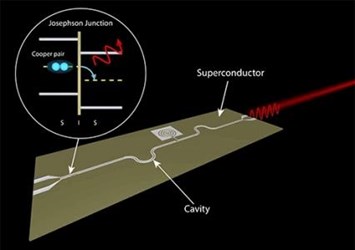Researchers Produce First On-Chip Microwave Laser For Quantum Computers
By Jof Enriquez,
Follow me on Twitter @jofenriq

Researchers at Delft University of Technology (TU Delft) and its quantum research institute, QuTech, have demonstrated a first-of-its-kind on-chip microwave laser produced from a Josephson junction embedded in a superconducting microwave cavity. These low-heat, ultra-efficient lasers are ideal for operating a quantum computer.
Named after Nobel Prize-winning scientist Brian Josephson, a Josephson junction is made by sandwiching a thin layer of a nonsuperconducting material between two layers of superconducting material. Josephson correctly predicted that pairs of superconducting electrons (Cooper pairs) could "tunnel" right through the thin, nonsuperconducting barrier from one superconductor to another – a quantum phenomenon called the Josephson effect, one of the basic concepts of superconductivity.
QuTech scientists fabricated a device made from a nanoscale Josephson junction strongly coupled to a high-quality factor superconducting micro-cavity. When the device is supercooled to below 1 Kelvin, and a small DC voltage is applied across the junction, microwave photons are produced and bounce back and forth between the two layers, or "mirrors" of superconducting material. The beam of microwave light emitted from the cavity is very energy efficient and uses less than a picoWatt of power to emit, more than 100 billion times less than a light globe.
While current microwave sources are expensive and inefficient, the Josephson junction laser created at QuTech is energy efficient. Conventional lasers are deemed less ideal for use in quantum computers since these are inefficient, and dissipate a lot of heat while lasing.
Generating microwaves from inside the chip itself, instead of getting it externally — as is typical in current devices — could result in less bulky systems, and affords greater control in manipulating quantum circuits, according to the researchers.
"The simple fabrication and operation allows for easy integration with a range of quantum devices, allowing for efficient on-chip generation of coherent microwave photons at low temperatures," they write in Science magazine.
The researchers plan to experiment using tunable Josephson junctions made from nanowires to allow for microwave burst for fast control of multiple quantum components. They are attempting to produce "amplitude-squeezed" light, which has smaller intensity fluctuations compared to conventional lasers, and are considered fundamental requirements in quantum communication protocols.
